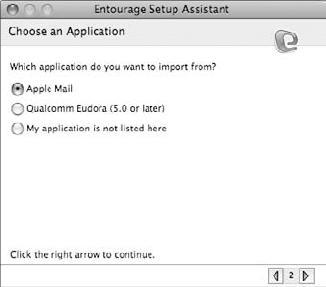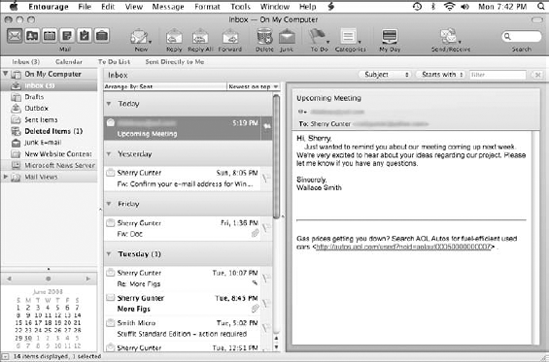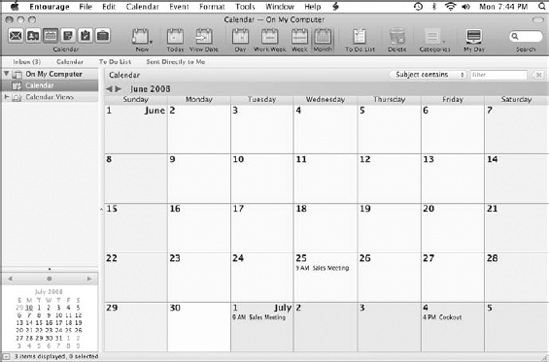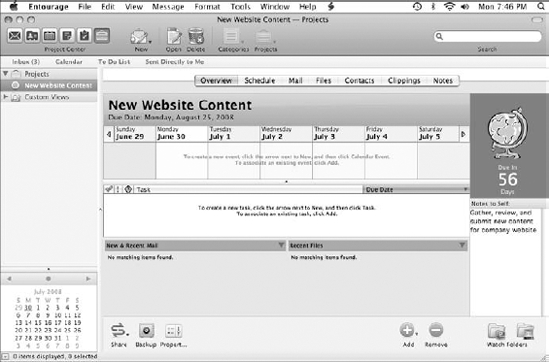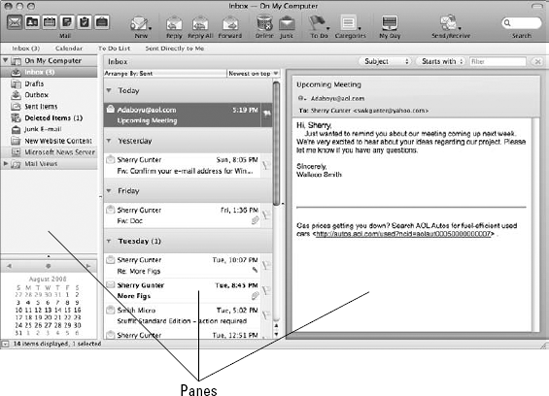IN THIS CHAPTER
Setting up an e-mail account with Setup Assistant
Learning about the Entourage features
Navigating the Entourage program window
If you're like most people today, your life is pretty complicated and often feels like it's going in a million different directions. Wouldn't it be nice to hire a personal assistant, someone who could come in each day and tell you what's on the agenda, where you need to go, what things need to be done, answer important e-mails, and hand you a nice cup of coffee? Entourage can do that, electronically speaking of course—except for the cup of coffee part. It doesn't do coffee. Not yet anyway. I hope to hear about an update soon to synchronize Entourage with a coffee pot. What a programming coup that would be!
Even without the cup of coffee part, Entourage is a great tool for keeping track of your busy life. Acting as both a project manager application and an e-mail client, Entourage can help you organize appointments, plan events, jot down notes, manage addresses and phone numbers, juggle a to-do list, and e-mail colleagues, friends, and family. It's starting to sound like you ought to be paying it to do all those things. At its very heart, Entourage is a tailored organizational tool you can use to help your complicated life seem a bit less complicated and a bit more organized. In this chapter, you learn how to set up Entourage, find your way around the program window and features, and import your favorite electronic address book.
When you first open Entourage, a Setup Assistant politely appears to ask you some pertinent questions before jumping into the program. This feature helps set up your e-mail accounts, import your address book, import any calendar info you have hanging around, and get everything up and running. Like many complex programs, Entourage needs some information from you first before it can get to its job being your personal information manager (PIM).
If you've never used Entourage and you're a new Mac user, you can start using Entourage without needing to import anything. If you're a seasoned Mac user and you've been using another e-mail program, chances are good you can import all the info into Entourage, such as your saved e-mail messages and address book. Lastly, if you've been using a previous edition of Entourage, the Setup Assistant can help you easily migrate all your info into the new edition.
When creating a new account, you must input all the necessary information about your e-mail account's incoming and outgoing server, server type, your account ID, and your password. If you're using a popular e-mail provider, such as Yahoo! Mail, EarthLink, Hotmail, or Gmail, the Setup Assistant can automatically fill in the information for you. If you're using a lesser-known service, you need to gather all the details and be prepared to enter them into the required fields.
If you're using Entourage through a corporate network, your e-mail account may run on a Microsoft Exchange server, a centralized system for handling networks in an office environment. If this is the case, you need to let the Setup Assistant know by checking the My account is on an Exchange server check box in the Set Up a Mail Account window, the second part of the Setup Assistant's walkthrough session.
Follow these steps to set up Entourage anew:
From the Setup Assistant's Welcome window (also called a page by the Setup Assistant), shown in Figure 24.1, click the Start using Entourage without importing anything radio button. This tells Entourage to create new e-mail and calendar data from scratch.
If you're importing or upgrading, you'll choose the appropriate option and view some different windows, as explained at the end of these steps.
Note
You also can set up new e-mail accounts at any time from the Entourage window. Choose Entourage

Click the right-arrow button to continue.
The Set Up a Mail Account window appears, as shown in Figure 24.2.
Type in your e-mail address, and click the right-arrow button to continue.
Setup Assistant tests the configuration settings and shows the results, as shown in Figure 24.3. Click the right-arrow button to continue.
If Entourage does not recognize your e-mail server, the Setup Assistant window says "Automatic Configuration Failed." You need to manually insert all the required information in the next window.
The Verify and Complete Settings window, shown in Figure 24.4, offers fields for filling in and verifying your e-mail account information. Fill out the fields as required by your e-mail service.

Figure 24.3. The Setup Assistant tests your mail account settings and tells you how it went in the Automatic Configuration Succeeded window.

Figure 24.4. You can fill in your e-mail account information in the Verify and Complete Settings window, including your account ID, password, and mail server addresses.
Note
If you don't know your account info, you need to contact your e-mail service. Check with your e-mail provider to learn more. If you're using another e-mail program, you also might glean this information from the program's account settings.
Click the right-arrow button to continue.
The Verify Settings window appears, as shown in Figure 24.5.
Click the Verify My Settings button.
The Setup Assistant checks your information to see if it's all valid and displays the results. If you've missed something, you need to return to the previous window and correct any errors.
If everything checks out, click the right-arrow button to continue.
The Setup Complete window appears, as shown in Figure 24.6, the final Setup Assistant window.
Assign a name to your account as it will appear in Entourage.
Leave the Add this new e-mail address to your Me contact check box activated to add the address to your address book feature in Entourage.
Leave the Include this account in my Send & Receive All schedule check box activated if you want this account checked automatically when sending and receiving e-mail.
Click Finish to exit the Setup Assistant.
Entourage prompts you to make the program the default e-mail client, as shown in Figure 24.7.
Click Make Default if you want Entourage to open whenever you click an e-mail link on a Web page; click No if you prefer to use another e-mail client as your default client.

Figure 24.7. One more thing before you can use your new account: Entourage wants you to make it the default e-mail client.
If you are using another e-mail program as your main e-mail client, Entourage can switch you over and import all the saved e-mail messages and address book data. You still work your way through the Setup Assistant steps; however, your windows will vary slightly from the previous set of steps, and depending on how successful the import is, you may have to input more account information, or you may be allowed to skip steps entirely. From the very first Welcome to Entourage window the Setup Assistant presents, you can click the Import from a previous version of Entourage radio button (refer to Figure 24.1). When you make this your selection in the first Setup Assistant window, the next window you see is the Choose an Application window, as shown in Figure 24.8.
As you can see from the figure, the list of e-mail programs is a bit slim. You can select from two: Apple Mail or Qualcomm Eudora (5.0 or later). If you're using one of these programs, select one and proceed to the next window, shown in Figure 24.9, where you can choose exactly which program elements you want to import.

Figure 24.9. When importing from Apple Mail or Qualcomm Eudora, you can specify which program elements you want to import.
If your e-mail program is not one of these two programs listed, you can tell the Setup Assistant that your application is not listed. When you proceed to the next window, the Setup Assistant explains that you can import mail messages in the MBOX format or import address books from the comma-delimited or text file format. After making your selection, you can specify which elements you want to import, such as rules, signatures, messages, and so on. Your list of import elements varies based on the type of import you select. When the import finally starts, it could take quite some time, so be patient.
If you are upgrading from an older version of Entourage, you can select the Import from a previous version of Entourage radio button in the Setup Assistant's Welcome window (refer to Figure 24.1). After making this selection, the next screen you see is the Import window, shown in Figure 24.10. Choose which application you're upgrading from, and then continue through the setup process to import the data.

Figure 24.10. The Setup Assistant's Import window lets you upgrade from a previous version of Entourage.
You can use the Account window to edit your e-mail account in Entourage. Choose Entourage
Entourage looks and acts a bit different than the other Office programs. Rather than dealing with just one work area window holding a document or spreadsheet, Entourage is composed of several key features. You can toggle between them based on what task you want to perform. Unlike the other programs, however, the Entourage window layout is primarily made of panes. You can still use a Standard toolbar at the top of the window to quickly perform common tasks, and the menu bar holds all the commands for using various features and tools. If you're new to Entourage, take a moment and familiarize yourself with the main features and window elements.
When you open the program, you'll notice six nicely lined-up icons on the left side of the Standard toolbar, shown in Figure 24.11. These icons represent the six key features. You can click an icon to view the feature. The following sections provide a rundown on what each feature does.
Figure 24.11. You can switch between the main features using these icon buttons found on the Standard toolbar.
Although very different in appearance from the other Office programs, Entourage still displays several of the same program window features. The following descriptions give you a look at the basic Entourage window elements.
At the top of the Entourage window sits the title and menu bar. This area lists the name of the program and the main menu categories. To reveal a menu, click the menu name; to activate a command, click the command name. Submenus or dialog boxes may appear for further user input. Figure 24.18 shows the Tools menu displayed.
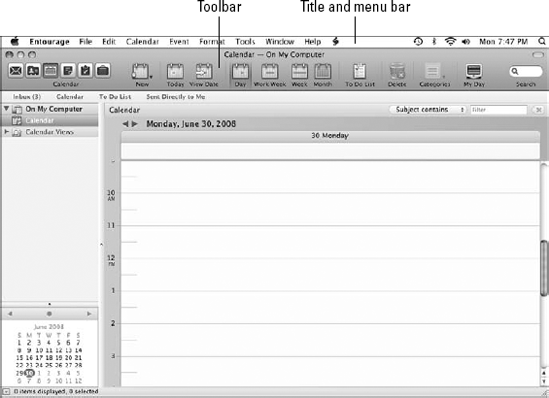
Figure 24.18. Entourage's title and menu bar display the name of the program and the main groups of menu commands.
Below the menu bar sit the window controls that allow you to close, minimize, and zoom the document window.
Directly below the title bar and menu bar is the one and only toolbar found in Entourage. The toolbar displays a row of tool icons for common Entourage tasks. The commands and tools that appear on the toolbar change based on whether you're viewing Mail, the Address Book, the Calendar, Notes, Tasks, or the Project Center. To activate a tool or command, just click the associated icon.
The Entourage feature windows utilize panes, shown in Figure 24.19, to list items such as tasks or e-mail messages. You can resize the panes to view more or fewer items onscreen. To resize a pane, move the mouse pointer over a pane border until the pointer icon changes to a double-sided arrow pointer, and then click and drag to adjust the pane size. Any pane border that has a tiny dot in the middle can be dragged to resize the pane.
In this chapter, you learned how to use the Setup Assistant to set up Entourage to work with your e-mail service provider. Entourage can help you create a new account, import an existing account, or upgrade from a previous version of the program. Setting up e-mail accounts has many nuances, so if you run into any trouble, be sure to check with your e-mail service provider for more information.
This chapter also introduced you to the six main features Entourage offers: Mail, Address Book, Calendar, Notes, Tasks, and Project Center. You can learn more about using these features in the chapters that follow.
You also learned how to find your way around the program window, viewing familiar and new program window elements. Now you're ready to start e-mailing, scheduling, and organizing your messages, appointments, tasks, and projects.





